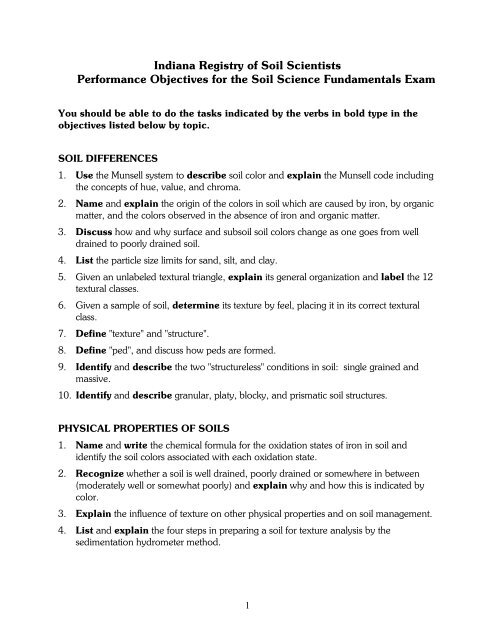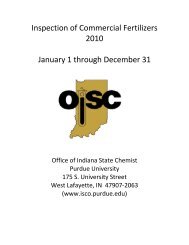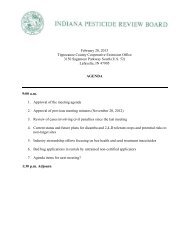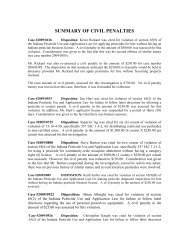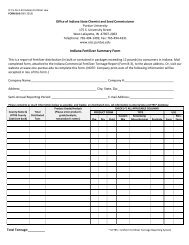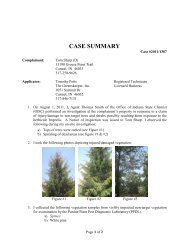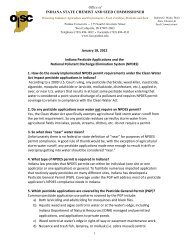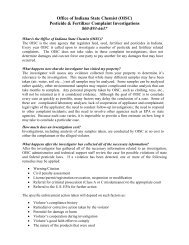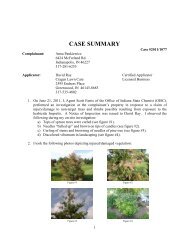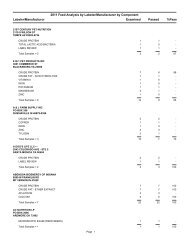Indiana Registry of Soil Scientists Performance Objectives for the ...
Indiana Registry of Soil Scientists Performance Objectives for the ...
Indiana Registry of Soil Scientists Performance Objectives for the ...
You also want an ePaper? Increase the reach of your titles
YUMPU automatically turns print PDFs into web optimized ePapers that Google loves.
<strong>Indiana</strong> <strong>Registry</strong> <strong>of</strong> <strong>Soil</strong> <strong>Scientists</strong><br />
<strong>Per<strong>for</strong>mance</strong> <strong>Objectives</strong> <strong>for</strong> <strong>the</strong> <strong>Soil</strong> Science Fundamentals Exam<br />
You should be able to do <strong>the</strong> tasks indicated by <strong>the</strong> verbs in bold type in <strong>the</strong><br />
objectives listed below by topic.<br />
SOIL DIFFERENCES<br />
1. Use <strong>the</strong> Munsell system to describe soil color and explain <strong>the</strong> Munsell code including<br />
<strong>the</strong> concepts <strong>of</strong> hue, value, and chroma.<br />
2. Name and explain <strong>the</strong> origin <strong>of</strong> <strong>the</strong> colors in soil which are caused by iron, by organic<br />
matter, and <strong>the</strong> colors observed in <strong>the</strong> absence <strong>of</strong> iron and organic matter.<br />
3. Discuss how and why surface and subsoil soil colors change as one goes from well<br />
drained to poorly drained soil.<br />
4. List <strong>the</strong> particle size limits <strong>for</strong> sand, silt, and clay.<br />
5. Given an unlabeled textural triangle, explain its general organization and label <strong>the</strong> 12<br />
textural classes.<br />
6. Given a sample <strong>of</strong> soil, determine its texture by feel, placing it in its correct textural<br />
class.<br />
7. Define "texture" and "structure".<br />
8. Define "ped", and discuss how peds are <strong>for</strong>med.<br />
9. Identify and describe <strong>the</strong> two "structureless" conditions in soil: single grained and<br />
massive.<br />
10. Identify and describe granular, platy, blocky, and prismatic soil structures.<br />
PHYSICAL PROPERTIES OF SOILS<br />
1. Name and write <strong>the</strong> chemical <strong>for</strong>mula <strong>for</strong> <strong>the</strong> oxidation states <strong>of</strong> iron in soil and<br />
identify <strong>the</strong> soil colors associated with each oxidation state.<br />
2. Recognize whe<strong>the</strong>r a soil is well drained, poorly drained or somewhere in between<br />
(moderately well or somewhat poorly) and explain why and how this is indicated by<br />
color.<br />
3. Explain <strong>the</strong> influence <strong>of</strong> texture on o<strong>the</strong>r physical properties and on soil management.<br />
4. List and explain <strong>the</strong> four steps in preparing a soil <strong>for</strong> texture analysis by <strong>the</strong><br />
sedimentation hydrometer method.<br />
1
5. Given Stokes Law, explain each factor in it and how each factor affects <strong>the</strong> settling<br />
velocity <strong>of</strong> particles (covered in lecture). Explain which variables are assumed to be<br />
constant and which ones are variable and thus influence <strong>the</strong> texture determination.<br />
6. Given ei<strong>the</strong>r, <strong>the</strong> percent sand, silt, and clay, or <strong>the</strong> hydrometer readings <strong>for</strong> a soil taken<br />
at 40 seconds and 2 hours, be able to use <strong>the</strong> textural triangle to determine textural<br />
class.<br />
7. Describe <strong>the</strong> importance <strong>of</strong> soil temperature and what management practices are<br />
useful in manipulating soil temperatures. Be able to list some soil properties that<br />
influence soil temperature.<br />
8. Determine bulk density and explain <strong>the</strong> relationship it has to pore space and why it is<br />
an important soil property.<br />
9. Calculate percent pore space when bulk density and particle density are given.<br />
10. Assess <strong>the</strong> importance <strong>of</strong> macro and micro pores in water retention and soil aeration<br />
and list three effects <strong>of</strong> poor aeration.<br />
SOIL FORMATION<br />
2. Understand TIME as a factor in soil <strong>for</strong>mation. Be able to list <strong>the</strong> changes that usually<br />
take place in soil as it ages.<br />
3. Describe how CLIMATE (temperature and precipitation) affects <strong>the</strong> (a) humus<br />
content and depth, (b) depth <strong>of</strong> wea<strong>the</strong>ring, (c) presence <strong>of</strong> an argillic (clay) horizon,<br />
and (d) exchangeable cation (Ca ++ , Mg ++ , K + ) composition <strong>of</strong> soils.<br />
4. Be able to (a) Explain what nutrient recycling by <strong>the</strong> plants does to a soil during soil<br />
<strong>for</strong>mation; (b) explain how marsh grass, prairie grass, deciduous trees and coniferous<br />
trees as vegetation types each produce a different soil; and (c) identify <strong>the</strong> most<br />
probable NATIVE VEGETATION by looking at <strong>the</strong> soil.<br />
5. Assess <strong>the</strong> effect <strong>of</strong> TOPOGRAPHY (slope and drainage) on soil development.<br />
Given a description or sketch <strong>of</strong> a landscape be able to predict where well drained and<br />
poorly drained soils will occur and where <strong>the</strong> deepest and darkest soils will occur.<br />
6. Define <strong>the</strong> term CATENA as used in soils.<br />
7. Distinguish <strong>the</strong> soil drainage classes (well, moderately well, somewhat poor and<br />
poorly drained soils) from <strong>the</strong> colors in <strong>the</strong> soil pr<strong>of</strong>ile.<br />
8. Identify and describe <strong>the</strong> residual PARENT MATERIALS common to <strong>Indiana</strong> and<br />
to locate <strong>the</strong> areas on a map.<br />
9. Identify and explain <strong>the</strong> differences between glacial till and glacial outwash and to<br />
locate <strong>the</strong> areas <strong>of</strong> Wisconsin and Illinoian glacial PARENT MATERIALS on an<br />
<strong>Indiana</strong> map.<br />
2
10. Define and identify loess and explain its mode <strong>of</strong> deposition and its areas <strong>of</strong><br />
prevalence as a PARENT MATERIAL in <strong>Indiana</strong>.<br />
11. Review pedon descriptions and learn <strong>the</strong> system <strong>of</strong> horizon designations.<br />
SOIL CLASSIFICATION<br />
1. Employ <strong>the</strong> system <strong>of</strong> "Rectangular Survey to:<br />
a) describe land locations and acreages.<br />
b) locate <strong>the</strong> land areas on soil survey or topographic maps when given <strong>the</strong> legal land<br />
description.<br />
3. List two advantages in having a workable system <strong>for</strong> classifying soils.<br />
4. Discuss <strong>the</strong> criteria used and <strong>the</strong> purpose <strong>for</strong> classifying soils in <strong>Soil</strong> Taxonomy.<br />
5. List <strong>the</strong> six categories (levels) <strong>of</strong> classification in <strong>Soil</strong> Taxonomy, <strong>the</strong> US system <strong>of</strong> soil<br />
classification, and put <strong>the</strong>m in order.<br />
6. Given <strong>the</strong> classification <strong>of</strong> a soil (e.g., Mollic Haplaqualfs), identify <strong>the</strong> <strong>Soil</strong> Order,<br />
Suborder, Great Group and Subgroup names.<br />
7. Name <strong>the</strong> 12 orders and some distinguishing features <strong>of</strong> each.<br />
8. Organize <strong>the</strong> following five soil orders into <strong>the</strong> most probable order <strong>of</strong> increasing<br />
development: Entisol, Inceptisol, Alfisol, Ultisol, and Oxisol.<br />
9. Describe 4 surface and 5 subsurface diagnostic horizons.<br />
10. Explain criteria used and purpose <strong>for</strong> classifying soils in <strong>the</strong> Land Capability Class<br />
System.<br />
EROSION AND WATER QUALITY<br />
1. Discuss <strong>the</strong> problems associated with soil erosion in: (1) agriculture, (2) urban<br />
development, and (3) recreation sites and especially to explain <strong>the</strong> general<br />
environmental concerns in all cases.<br />
2. Describe <strong>the</strong> two mechanisms (detachment and transport) recognized in accelerated<br />
erosion by water and wind.<br />
3. Define <strong>the</strong> universal soil loss equation (USLE) and explain what each symbol<br />
represents.<br />
5. Explain what determines <strong>the</strong> magnitude <strong>of</strong> <strong>the</strong> T value, rainfall factor, R and <strong>the</strong> soil<br />
erodibility factor, K.<br />
6. Describe how length <strong>of</strong> slope and steepness <strong>of</strong> slope is related to <strong>the</strong> amount <strong>of</strong> soil<br />
erosion by water.<br />
7. Explain <strong>the</strong> reasons <strong>for</strong> tilling <strong>the</strong> soil.<br />
3
8. Describe four tillage systems commonly used in <strong>Indiana</strong>.<br />
9. Explain how each tillage system affects <strong>the</strong> amount <strong>of</strong> erosion occurring (i.e., <strong>the</strong> size<br />
<strong>of</strong> <strong>the</strong> cropping management factor, C).<br />
10. List three common conservation practices used to reduce <strong>the</strong> conservation practices<br />
factor, P, and explain how each is effective in reducing erosion and how effective it is.<br />
11. Recall <strong>the</strong> approximate magnitude <strong>of</strong> <strong>the</strong> values <strong>of</strong> R, K, LS, C, P, and T <strong>for</strong> <strong>Indiana</strong><br />
conditions on tilled land.<br />
WATER IN SOILS<br />
1. Explain <strong>the</strong> polarity and hydrogen bonding properties <strong>of</strong> water.<br />
2. Explain why we have cohesive and adhesive <strong>for</strong>ces in soil-water systems and what<br />
adhesion water and cohesion water is.<br />
3. Discuss <strong>the</strong> concept <strong>of</strong> soil water potential and its various components <strong>of</strong> "suction" and<br />
"tension" and <strong>the</strong> method <strong>of</strong> expressing <strong>the</strong>ir magnitudes in units <strong>of</strong> bars and/or<br />
kilopascals (kPa). Also explain <strong>the</strong> difference between <strong>the</strong> "amount" <strong>of</strong> soil moisture<br />
and "how tightly it is held" in <strong>the</strong> soil.<br />
4. Calculate % moisture by weight and by volume.<br />
5. Explain how to measure <strong>the</strong> amount <strong>of</strong> soil water gravimetrically, by neutron<br />
scattering (with <strong>the</strong> neutron probe), with water potentiometers (tensiometers), by timedomain<br />
reflectrometry (TDR), and by electrical conductivity.<br />
6. Define saturated (gravitational) and unsaturated (capillary) flow <strong>of</strong> water in soils.<br />
7. Use <strong>the</strong> concepts <strong>of</strong> water content at "saturation", "field capacity", and <strong>the</strong> "permanent<br />
wilting point" and know how <strong>the</strong>y are related to plant-"available" and "unavailable"<br />
water. Calculate "available" water in soils.<br />
8. Recall <strong>the</strong> approximate amount <strong>of</strong> rain water a sandy loam and a clay loam soil can<br />
store as available water (in cm/meter <strong>of</strong> inches/foot).<br />
9. Describe capillary rise <strong>of</strong> water from a water table and how it differs <strong>for</strong> sand, silt and<br />
clay.<br />
10. Explain with a sketch, <strong>the</strong> functioning <strong>of</strong> <strong>the</strong> Prescription Athletic Turf (P.A.T.) system.<br />
11. Discuss <strong>the</strong> fate <strong>of</strong> rain water (evaporation, transpiration, run<strong>of</strong>f and percolation).<br />
12. Discuss <strong>the</strong> effects <strong>of</strong> mulches on water intake (infiltration) and water loss.<br />
13. Explain how fallowing accumulates water in dry region soils.<br />
14. Describe <strong>the</strong> kinds <strong>of</strong> soils best suited <strong>for</strong> irrigation and discuss several <strong>of</strong> <strong>the</strong><br />
practices important <strong>for</strong> making irrigation pr<strong>of</strong>itable.<br />
15. Describe <strong>the</strong> various surface, subsurface, sprinkler and drip methods <strong>for</strong> applying<br />
irrigation water.<br />
4
16. Explain how systems <strong>of</strong> surface drainage and tile drainage work, and be able to<br />
discuss at least 3 benefits from improved drainage.<br />
SOIL COLLOIDS AND CATION EXCHANGE CAPACITY<br />
1. List <strong>the</strong> two types <strong>of</strong> soil colloids which are responsible <strong>for</strong> <strong>the</strong> negative charge<br />
exhibited by soils.<br />
2. Define cation exchange capacity and write <strong>the</strong> units used in expressing it.<br />
3. Explain what we mean by a mole and a centimole <strong>of</strong> charge, and be able to calculate<br />
<strong>the</strong> centimole weight <strong>for</strong> simple ions, complex ions, and compounds.<br />
4. Identify <strong>the</strong> origin <strong>of</strong> <strong>the</strong> negative charge on clay minerals; both that resulting from<br />
exposed crystal edges and that from isomorphic substitution.<br />
5. Diagram and label <strong>the</strong> various structural features <strong>of</strong> <strong>the</strong> following clay minerals:<br />
a) Kaolinite (1:1, nonexpanding)<br />
b) Hydrous Mica (Illite, 2:1, nonexpanding)<br />
c) Montmorillonite (2:1, expanding)<br />
6. Compare and contrast how each <strong>of</strong> <strong>the</strong> clay minerals affect <strong>the</strong> soil properties <strong>of</strong> water<br />
holding capacity, shrink-swell, nutrient holding capacity.<br />
7. List two sources <strong>of</strong> negative charge on soil humus.<br />
8. Recall <strong>the</strong> approximate cation exchange capacity (CEC) <strong>for</strong> humus, montmorillonite,<br />
illite, and kaolinite.<br />
9. Calculate <strong>the</strong> cation exchange capacity (CEC) and <strong>the</strong> % base saturation (% B.S.) <strong>of</strong> a<br />
soil, given <strong>the</strong> quantity <strong>of</strong> cations distributed on <strong>the</strong> soil exchange sites.<br />
10. Calculate approximate values <strong>for</strong> <strong>the</strong> CEC <strong>of</strong> mineral and organic soils, given <strong>the</strong> clay<br />
and humus content.<br />
11. Assess <strong>the</strong> relative importance <strong>of</strong> cation exchange <strong>for</strong> fertilizer and lime retention, and<br />
waste product purification.<br />
12. Explain how K + , Na + , Mg ++ , Ca ++ , H + and Al +++ compete <strong>for</strong> cation exchange sites on<br />
soil colloids.<br />
SOIL pH and LIMING<br />
1. Explain <strong>the</strong> concept <strong>of</strong> "pH". When given <strong>the</strong> pH, be able to calculate H +<br />
concentration in terms <strong>of</strong> molarity (M) and vice versa.<br />
2. Explain why soils are acid or alkaline. Be able to show by chemical equations how<br />
H + , Al +++ , Ca ++ and Na + in conjunction with soil particles and water produce alkalinity<br />
or acidity.<br />
5
3. Differentiate between "reserve" (i.e. associated) and "active" (i.e. dissociated) acidity.<br />
4. Describe how soils "buffer" <strong>the</strong> effect <strong>of</strong> liming on acidification.<br />
5. Describe <strong>the</strong> relationship that exists between pH and percent base saturation and<br />
diagram this relationship <strong>for</strong> a typical soil.<br />
6. Explain how soil pH is measured by indicator dyes and by <strong>the</strong> glass electrode pH<br />
meter and give a brief explanation <strong>of</strong> <strong>the</strong> technique used in each..<br />
8. Calculate, given <strong>the</strong> centimoles <strong>of</strong> acid per kg soil, <strong>the</strong> amount <strong>of</strong> CaCO 3 needed per<br />
kg soil (and per acre or hectare) to neutralize it.<br />
9. Explain how soils become acid from wea<strong>the</strong>ring and cropping.<br />
10. Explain why pH affects crop growth and assess <strong>the</strong> effect <strong>of</strong> pH on <strong>the</strong><br />
a. solubility <strong>of</strong> aluminum, iron and manganese and similar metal ions<br />
b. availability <strong>of</strong> calcium and magnesium<br />
c. availability <strong>of</strong> phosphate and molybdate<br />
d. activity <strong>of</strong> soil microorganisms<br />
11. List <strong>the</strong> materials used to acidify a soil and describe how <strong>the</strong>y work.<br />
12. List which <strong>of</strong> <strong>the</strong> compounds (CaO, Ca(OH) 2 , CaCO 3 , CaCl 2 , CaSO 4 , MgCO 3 , Mar1)<br />
are good liming materials and explain why each is or is not a good liming material.<br />
13. Explain <strong>the</strong> importance <strong>of</strong> each <strong>of</strong> <strong>the</strong> following in determining <strong>the</strong> quality <strong>of</strong> a liming<br />
material.<br />
a) its neutralizing value (calcium carbonate equivalent)<br />
b) its Ca and Mg content<br />
c) its fineness<br />
ORGANISMS OF THE SOIL<br />
1. Name several types <strong>of</strong> soil animals, give a brief description, and explain <strong>the</strong>ir<br />
importance.<br />
2. Describe <strong>the</strong> methods used <strong>for</strong> extracting animals from <strong>the</strong> soil (e.g. Berlese funnel<br />
and <strong>the</strong> nematode extracting system).<br />
3. Explain how we measure microorganism activity by CO 2 evolution and <strong>the</strong> serial<br />
dilution plating techniques.<br />
4. Name a parasitic or pathogenic soil organism and describe how it causes plant<br />
disease or injury.<br />
5. Describe mycorrhizae and explain <strong>the</strong>ir importance to higher plants.<br />
6. Diagram <strong>the</strong> nitrogen cycle including its pathways and <strong>the</strong> soil organism involved.<br />
6
7. Differentiate between aerobic, anaerobic, autotrophic (chemolithotrophs), and<br />
heterotrophic (chemoorganotrophs).<br />
8. Explain symbiotic and nonsymbiotic N fixation and its importance to both cultivated<br />
and natural ecosystems.<br />
9. Name <strong>the</strong> soil bacteria responsible <strong>for</strong> N fixation and nitrification, and be able to<br />
describe <strong>the</strong> conditions that favor each.<br />
10. Explain why one would use a nitrification inhibitor and how a commonly used one<br />
functions.<br />
11. Describe <strong>the</strong> influence <strong>of</strong> pesticides and fertilizers on soil organisms.<br />
12. Explain how one sterilizes soil, <strong>the</strong> effects <strong>of</strong> soil sterilization, and when it is used.<br />
13. Discuss bioremediation and how it can be used to cleanup environments<br />
contaminated with hazardous organic waste.<br />
ORGANIC SOILS AND ORGANIC MATTER<br />
1. Explain how muck and peat soils develop.<br />
2. List <strong>the</strong> criteria which distinguishes a mineral soil from an organic soil.<br />
3. Distinguish between a peat and a muck soil.<br />
4. List <strong>the</strong> characteristics <strong>of</strong> sedimentary, fibrous and woody peats.<br />
5. List two commercial uses <strong>of</strong> peats and mucks.<br />
6. List and explain <strong>the</strong> soil order and suborder classification <strong>for</strong> organic soils.<br />
7. List at least five management problems which occur with organic soils.<br />
8. List and explain four economic factors which must be considered be<strong>for</strong>e starting to<br />
farm organic soils.<br />
9. Explain <strong>the</strong> effects <strong>of</strong> native vegetation and drainage on organic matter accumulation.<br />
10. Know <strong>the</strong> approximate C:N ratio <strong>of</strong> soil humus, soil organisms, and common<br />
residues, such as alfalfa, manure, corn stalks, wheat straw, and sawdust.<br />
11. Explain how <strong>the</strong> addition <strong>of</strong> residues with different C:N ratios affects decomposition<br />
rate and N availability as related to mineralization and immobilization.<br />
12. List and explain ways to compensate <strong>for</strong> wide C:N ratios in residues and avoid N<br />
deficiencies.<br />
13. Explain <strong>the</strong> importance <strong>of</strong> organic matter to <strong>the</strong> physical and chemical properties <strong>of</strong><br />
soils.<br />
7
PLANT AND SOIL ANALYSIS<br />
1. List (correctly spelled) from memory all <strong>of</strong> <strong>the</strong> 18 elements essential <strong>for</strong> plants and<br />
classify each as a macronutrient (primary or secondary) or micronutrient.<br />
2. Given an essential element, write <strong>the</strong> ionic or molecular <strong>for</strong>ms <strong>of</strong> it which are taken<br />
up by plants.<br />
3. List <strong>the</strong> three steps in plant and soil analysis: sampling, analysis, interpretation.<br />
4. Describe in detail how to sample a field <strong>for</strong> plant analysis including sample taking,<br />
preparation and submission. Discuss good soil sampling procedures including<br />
number <strong>of</strong> sub-samples, size and type <strong>of</strong> area to sample, depth <strong>of</strong> sample, and sources<br />
<strong>of</strong> error in sampling.<br />
5. Identify what plant part and at what growth stage one should sample tomatoes, corn<br />
and oak <strong>for</strong> plant analysis.<br />
6. Explain how actual plant analysis is done in a certified lab including what analyses<br />
are made.<br />
7. Given any one <strong>of</strong> <strong>the</strong> elements commonly reported in plant analysis, recall whe<strong>the</strong>r<br />
<strong>the</strong> sufficiency level is more appropriately reported in percent or in ppm.<br />
8. Given values from plant analysis <strong>for</strong> N, P, or K, be able to select <strong>the</strong> values falling<br />
within <strong>the</strong> "sufficiency" range.<br />
9. Explain "Phosphorus Fixation".<br />
10. Explain "Potassium Fixation".<br />
11. Explain why a soil nitrogen test is usually not run and how N needs are determined.<br />
12. List <strong>the</strong> tests run in a "routine" or "basic" soil test.<br />
13. Explain how a soil test lab obtains a soil's cation exchange capacity, and be able to do<br />
<strong>the</strong> calculations when given <strong>the</strong> appropriate data.<br />
FERTILIZERS<br />
1. Discuss animal and municipal wastes: a) as fertilizers; b) from an economic<br />
standpoint; and c) from an environmental standpoint.<br />
2. Describe <strong>the</strong> basic processes <strong>for</strong> manufacturing ammonia, ammonium nitrate, urea,<br />
diammonium phosphates, and nitrogen solutions.<br />
3. Recall <strong>the</strong> chemical composition and percent nitrogen <strong>of</strong> anhydrous ammonia,<br />
ammonium nitrate, urea, 28% N solutions and diammonium phosphate.<br />
4. Discuss <strong>the</strong> advantages and disadvantages <strong>of</strong> <strong>the</strong> gas, liquid, and solid <strong>for</strong>ms <strong>of</strong> N<br />
fertilizer as affected by cost, analysis, and handling ease.<br />
5. Explain how slow release fertilizers are made from urea and <strong>the</strong> special uses <strong>for</strong> <strong>the</strong>m.<br />
8
6. Explain <strong>the</strong> process used to produce <strong>the</strong> three kinds <strong>of</strong> phosphorus fertilizers (rock<br />
phosphate, concentrated super phosphate, and ammonium phosphates) and <strong>the</strong>ir<br />
chemical composition and % P 2 O 5 .<br />
7. Discuss <strong>the</strong> advantages and disadvantages <strong>of</strong> <strong>the</strong> three <strong>for</strong>ms <strong>of</strong> phosphate fertilizer as<br />
affected by cost and solubility.<br />
8. Explain <strong>the</strong> process used to produce <strong>the</strong> two common kinds <strong>of</strong> potassium fertilizers<br />
and <strong>the</strong> chemical composition and % K 2 O <strong>of</strong> each.<br />
9. Discuss <strong>the</strong> advantages and disadvantages <strong>of</strong> two <strong>for</strong>ms <strong>of</strong> potassium fertilizers as<br />
affected by cost and crop species.<br />
10. Explain <strong>the</strong> differences between blended and granular fertilizers and between solution<br />
and suspension fertilizers.<br />
11. Explain what a fertilizer label means.<br />
12. Explain how <strong>the</strong> fertilizer control law provides <strong>for</strong> inspection and en<strong>for</strong>cement <strong>of</strong><br />
fertilizer quality.<br />
13. Calculate <strong>the</strong> conversion factor and convert % P or K to % P 2 O 5 or K 2 O or <strong>the</strong><br />
reverse.<br />
FERTILIZER PRACTICES<br />
1. Diagram, label, and discuss a graph illustrating typical response <strong>of</strong> crop yield to<br />
added fertilizer.<br />
2. List and explain <strong>the</strong> factors that determine <strong>the</strong> amount <strong>of</strong> fertilizer needed.<br />
3. Explain <strong>the</strong> influence <strong>of</strong> relative mobility <strong>of</strong> N, P, and K in soil on fertilizer placement<br />
and timing.<br />
4. Discuss reasons <strong>for</strong> selecting preplanting, at planting, or postplanting as a time <strong>for</strong><br />
fertilizer application.<br />
5. Explain and demonstrate how fertilizer recommendations are made.<br />
6. Explain <strong>the</strong> differences between broadcast and o<strong>the</strong>r methods <strong>of</strong> fertilizer application<br />
and <strong>the</strong> advantages and <strong>of</strong> each method.<br />
7. Explain <strong>the</strong> effects <strong>of</strong> fertilizers on soil pH.<br />
8. Explain <strong>the</strong> concept <strong>of</strong> "diminishing returns". Show <strong>the</strong> difference in point <strong>of</strong> maximum<br />
yield and point <strong>of</strong> maximum pr<strong>of</strong>it per acre.<br />
SOILS AND CHEMICAL POLLUTION<br />
1. Describe toxic chemicals focusing on <strong>the</strong> environmental damage caused by <strong>the</strong>se<br />
organic compounds.<br />
9
2. Differentiate <strong>the</strong> various classes <strong>of</strong> pesticides, insecticides, fungicides, herbicides, and<br />
nematicides.<br />
3. Explain <strong>the</strong> behavior <strong>of</strong> organic chemicals in soil, give a brief description <strong>of</strong> volatility<br />
sorption, leaching, contamination <strong>of</strong> groundwater, chemical reactions, microbial<br />
metabolism, plant adsorption, and persistence in soil.<br />
4. Understand <strong>the</strong> effects <strong>of</strong> pesticides on soil organisms.<br />
5. Explain <strong>the</strong> key parameters affecting movements <strong>of</strong> pesticides through soil 1) Half life<br />
<strong>for</strong> biodegradation <strong>of</strong> <strong>the</strong> pesticide and 2) The partition coefficient (written as Kd and<br />
Koc).<br />
6. Describe how Kd and Koc differ.<br />
7. Describe <strong>the</strong> factors affecting biodegradation: photodegradation, hydrolysis, and<br />
microbial degradation.<br />
8. Explain pesticide movement into tile drains.<br />
9. Explain why nitrates move in soil and can potentially contaminate groundwater.<br />
10. Describe bioaccumulation/bioconcentration.<br />
11. Discuss land application <strong>of</strong> sewage sludge and <strong>the</strong> potential buildup <strong>of</strong> heavy metals.<br />
10


